Tom Brudenell (Thomas James Brudenell), a painter, muralist and qualified art therapist who now resides in Canada, was born 18 July 1937 in Kansas City, and lived in the Lake Chapala region for several years in the late 1960s.
When he was a child, Brudenell’s family moved frequently, living for extended periods in Chicago, Sheboygan (Wisconsin) and Kansas City (Missouri). His father was a mechanical engineer, whose own education was cut short by the second world war when he was sent to Caterpillar to help design tank engines.
Brudenell was an active and mischievous child, with great curiosity for the world around him. He excelled in athletics, drawing, desert lore, and all branches of science.
The earliest transformative experience he remembers came when he was seven years old and first saw the Rocky Mountains. Coming from the Great Plains, in the family Plymouth en route to California along Rte. 66, he was awestruck, initially thinking that the mountains were cloud formations.
Brudenell left high school on a full scholarship to study chemical engineering at Rensselaer Polytechnic Institute (RPI), a private research university located in Troy, New York. Coming to the realization that he wanted more than a pure science education, he transferred to the University of California at Berkeley.
At Berkeley, he roomed with archaeology student Len Foote, beginning a lifelong friendship. Brudenell took courses in psychology, the history of art and architecture (given by Walter Horn), literature, and studio art courses taught by Glenn Anthony Wessels (1895-1982), then close to retirement.
After completing his bachelor’s degree in psychology in 1961, Brudenell was drafted into the U.S. Navy, was made an officer, but resigned his commission in 1962 at the time of the Cuban Missile Crisis. He returned to Berkeley and spent the next several years there.
In mid-1965, Brudenell was one of several volunteers who joined Foote, now a qualified archaeologist, on a summer dig in Tizapán el Alto, on the southern shore of Lake Chapala. Brudenell’s job was to live on an isolated rancho, sift earth for pot shards, and explore some caves in the nearby hills.
In September 1965, Brudenell started work as a research assistant in psychology for Dr. Gordon Paul at the University of Illinois. He still found plenty of time to paint, and held a two-person show, with Eva Wei, in 1966, before cutting his research short. By a strange coincidence, four years later he met one of his Illinois professors unexpectedly at the Chula Vista Myth-Mass. Paul asked what he was doing in Mexico, and Brudenell replied that he was painting, writing and experimenting with sensory stimulants – smell bulbs – as olfactory triggers for the recall of past experiences; in fact, he was doing precisely what he had not been able to do in the graduate psychology program at the University of Illinois.
After Illinois, and prior to Mexico, Brudenell spent most of 1967 working in Pueblo Pintado, under the auspices of VISTA (Volunteers in Service to America), with the Navajo Nation, New Mexico.
Move to Mexico
Brudenell moved to Mexico in late 1967. The truck he was driving broke down on the south side of lake, just beyond Jocotepec. He sold it on the spot to a local mechanic for $150, and rented a house in the village. He remained in Jocotepec until mid-1970, painting and filling a series of sketch books and journals.
Even a severe bout of hepatitis served as fuel for his thoughts; it resulted in an extraordinarily intense series of journal entries, “hepatitis dreams”, musings and ideas. Brudenell credits his recovery from hepatitis to the conscientious nursing of Beverly Johnson, a free-spirited young woman with a brood of children, who was also Ajijic’s unofficial village photographer.
Brudenell credits fellow Jocotepec-based artist Donald Shaw, a “vigorous, larger-than-life” painter and sculptor, with convincing him to meet other artists and display his work. Brudenell recalls how Shaw remarked, in a very early conversation, and on account of Brudenell not reciprocating visits or offers of friendship, that he had never previously met anyone who had no ego.
In March 1968, works by Brudenell were included in the inaugural show, entitled “10 Jalisco artists”, at Galeria Ajijic Bellas Artes A.C., organized by Hudson and Mary Rose. That gallery was at Marcos Castellanos #15 in Ajijic, at the intersection with Calle Constitución.
Later that year (31 May-21 June), Brudenell was given his first solo exhibition at the same gallery. His artwork was enthusiastically reviewed by Allyn Hunt for Guadalajara’s Colony Reporter. Hunt urged readers in Guadalajara to take a trip out to the lake: “The most impressive work in this show is the recently-produced “Passage of the Patient Tortoise” which is stunning for its daring compositional structure, its brilliant color use, and its lucid and intelligently-styled forms. This single piece is more than worth the trip to the lake.” Brudenell was familiar with tortoises from his time in the desert south-west and, indeed, shared his Jocotepec home with one.
A few months later, in September 1968, Brudenell was one of 8 painters and a sculptor displayed at the “re-opening” of Laura Bateman’s Rincon del Arte gallery at Calle Hidalgo #41 in Ajijic. The single sculptor was Joe Wedgewood, recently arrived from Santa Monica, California. The other artists were Alejandro Colunga, Coffeen Suhl, Peter Paul Huf, Eunice (Hunt) Huf, John K Peterson, Jack Rutherford and (Donald) Shaw. (Shaw preferred to be known only by his surname.)
Friday 13 Dec 1968 saw the “grand opening” of La Galería, Zaragoza #1, Ajijic, a gallery run by a co-operative of local artists, including Peter Paul Huf and Eunice Hunt. The opening show entitled “Art is Life; Life is Art”, ran through to 10 January 1969 and featured works by Tom Brudenell, Alejandro Colunga, John Frost, Paul Hachten, Peter Paul Huf, Eunice Hunt, John K Peterson, Jack Rutherford, José Ma. de Servin, Shaw, Cynthia Siddons and sculptor Joe Wedgwood.
Brudenell also showed his work in a collective exhibit that opened 18 April 1969 at La Galería, Ajijic, alongside the works of John K Peterson, Charles Henry Blodgett, John Brandi, Peter Paul Huf, Eunice Hunt, Jack Rutherford, Shaw, Cynthia Siddons and Robert Snodgrass.
Brudenell’s works were also shown in Guadalajara, at the Galeria 8 de Julio. At the opening of one show in that city, a brawl erupted when a friend of Brudenell’s, visiting from Oakland, took offense at what he considered a discourteous act towards his girlfriend. The provocateur, who had no invitation to the opening, was a local street-gang leader, and the two men quickly squared off. Things turned nasty when the other members of the street gang turned up. A fist fight broke out, and rocks were thrown. When the gallery guests, and members of the musical band, pulled his friend inside, and barricaded the windows and doors, Brudenell was left behind in the street, where he explained to the street youths why he was sad, not angry, that the people inside the gallery, who painted and collected Mexican-inspired works, were so disconnected from most Mexicans. That was the night when the seed of Brudenell’s “People’s Murals” was planted, a seed that would germinate and flourish in the next few years.
North of the border, Brudenell’s work has been shown in galleries in San Francisco (Puma Gallery), Los Angeles (Ankrum), Victoria, B.C. (Beau Xi) and Friday Harbor, Washington (The Cannery Gallery) and the San Diego Art Museum. Brudenell generally declined to attend openings, preferring to simply send his works from whichever remote studio-home he happened to be in at the time.
Examples of pen and ink drawings from Brudenell’s time in Jocotepec
The image to the left shows one of a series (1974-1984) of pen-and-ink drawings by Brudenell, meant to appeal to a broader range of tastes and more decorative and salable than his meditative, more personal works.
The drawings were used for serigraphed prints and lithographed cards in the period 1974-1984. Most of them were sold in the Royal British Columbia Museum, Victoria.
By the early 1970s, Brudenell, who had never signed his name on the front of a painting, stopped signing them at all, preferring to use a circumpunct (a dot enclosed by a circle) which came to signify the state of observing without the observer.
The original drawing for Cows (below) dates to the late 1960s, though the print is dated 1970.
The Re-Creation of Adam (serigraphed print from original ink drawing of 1969) was “also somewhat commercial, but for a more reflective audience, this was the product of doodling and just letting forms appear without direction. Notice the tortoise or turtle coming into the picture!”
By the time he left Mexico, Brudenell’s canvas painting was exploring “the edge”, where matter and energy meet. His “Hepatitis Dreams” writing and his “Micro-macro edge” paintings date from this period.
The Chula Vista Myth-Mass
On 13 June 1969, Brudenell joined with Shaw snd John Brandi (all three artists were living in Jocotepec) in staging a Cocktail Party Myth-Mass or “happening”, in a building alongside the Chula Vista motel, mid-way between Ajijic and Chapala.
In autobiographical notes written later for the Emily Carr College Outreach program, Brudenell summarizes the event as follows:
“Worked with poet John Brandi and painter Donald Shaw to create early forms of “audience participation” shows such as the highly ritualized light-show “Myth-Mass” (Ajijic, Mexico, 1969) where Mr. Brudenell’s brush searched for universes beyond the limits of the biologist’s microscope and the astronomer’s telescope.”
Quick trip back to Berkeley in summer 1969
Shortly after the Chula Vista event, Brudenell made a trip north to Berkeley to complete his mixed-media “book objects” for a San Diego Art Museum Show. A private showing, sponsored by Gene and Lee Novak, was held at the Berkeley residence of Mr. William Turner. The Novaks, who apparently published various off-beat works and poetry, subsequently issued limited edition versions of two of Brudenell’s “visual books”: Thaw and Mim.
It was on this trip that Brudenell met and fell in love with Suzie. Suzie later visited Brudenell in Jocotepec and the couple traveled in her VW Bug through several parts of Mexico, from the Gulf coast to the Baja California Peninsula. Brudenell painted “Artist” on the side of the Bug, which never failed to attract great interest from passers-by. (Similar to the experience of Mary Fuller McChesney years earlier.)
Besides Shaw and John Brandi, Brudenell became acquainted in Jocotepec with several other local artists including photographer John Frost, and the bearded, khaki-loving John Thompson. Ray Cooper, a painter Brudenell had known in Berkeley, visited and spent some time with him one winter.
Two other artists then living in Jocotepec, painter Bruce Sherratt and his wife sculptor Lesley Jervis Maddock, both from the U.K., apparently kept themselves so much to themselves that Brudenell, reclusive by nature, never met them.
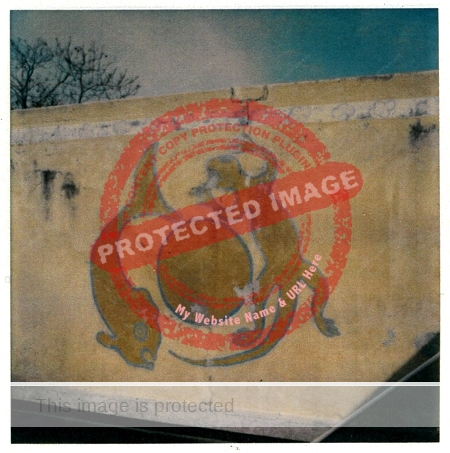
Tom Brudenell: Detail of mural at La Primavera, painted 1970, photographed 1979; reproduced by kind permission of the artist.
Brudenell’s first mural
In 1970, during his third and final year living in Jocotepec, Brudenell painted his first ever murals, at the Rio Caliente hotel-spa in the Primavera Forest, just west of Guadalajara, at the invitation of the spa’s owner, Dr. B. Lytton Bernard. Brudenell may not have had any previous experience of murals, but he did have considerable experience of house painting and wall preparation.
Sadly, in spite of the paint chemist of Sherwin-Williams in Guadalajara giving Brudenell PVC emulsion, these particular murals, on an exterior wall, lasted less than a decade, due to spalling of the walls’ concrete substrate and the spa’s sulfurous moisture. They were decorative murals and, given the Mexican sun and geothermal steam, were never likely to remain pristine for long.
The Rio Caliente murals may have been Brudenell’s first, but they were certainly not his last.
Leaves Jocotepec to return north
By mid-1970, Brudenell and Suzie had left Mexico, and were traveling up the coast of Oregon, for Washington State and British Columbia, Canada. Brudenell painted murals in exchange for rent, food and beer money, while Suzie worked as a cocktail waitress. A fishermen’s tavern in Astoria, Oregon, was the site of Brudenell’s first “People’s Mural” in the U.S., and was painted in exchange for all the beer he could drink and $20 on completion.
Over the next few years, he conducted the painting of more than 80 school and community murals, mostly for the Washington State Arts Commission. Brudenell supplied the wall preparation and the organization; the students supplied the ideas and art.
He also painted several murals in the early 1970s in the city of Portland, and two 30 foot x 40 foot murals on the 8-story Belmont Building in Victoria, B.C. (1973), which can still be admired today, forty years later.
In 1978, Brudenell emigrated from Shaw Island, Washington State, to British Columbia, complete with his pick-up truck and donkey! While building a pole-frame cabin, he lived in a tent during an unusually snowy winter on Hornby Island.
Shortly after meeting Dianne (later to become his wife), the couple built a home on ten acres of raw forest land on nearby Denman Island, where they lived during the 1980s as homesteaders. Brudenell spent several months each year conducting his collaborative murals in remote areas of Washington State.
Throughout his career, Brudenell has alternated between painting large-scale works such as murals, followed by a period of smaller, more intricate, highly detailed paintings of subjects such as an individual rock or a single clump of moss.
Brudenell’s three years painting in Jocotepec at the western end of Lake Chapala were creative and formative years. Much of his later work, especially his paintings, are evidence of a lasting Mexican influence on his composition and use of color. In Brudenell’s words,
“Color-vibrations are seen everywhere in Mexican and Indian designs. The natural flora exudes purples in sharp contrast with lime greens, reds flashing next to blues. Intense sunlight can dominate flat surfaces and color-vibrations, strong forms and colors shout back so that they find a happy balance.”
In the words of one reviewer, “All of Tom’s murals show a strong Mexican influence with earth colors…”
Brudenell himself treasures the words of Allyn Hunt, Editor of the Guadalajara Colony Reporter, who, after studying one of his early works, The Passage of the Patient Tortoise, informed his readers that Brudenell’s work, “for all of its simplification is much too sophisticated for a few seconds’ attention.”
This post was updated in October 2015.
Sources:
- Tom Brudenell, first interviewed at his home on Vancouver Island in February 2015.
- Allyn Hunt. Review of group show “10 Jalisco artists”, in “Art Probe”, Colony Reporter, 27 April 1968.
Sombrero Books welcomes comments, corrections or additional material related to any of the writers and artists featured in our series of mini-bios. Please use the comments feature at the bottom of individual posts, or email us.
Tony Burton’s books include “Lake Chapala: A Postcard History” (2022), “Foreign Footprints in Ajijic” (2022), “If Walls Could Talk: Chapala’s historic buildings and their former occupants” (2020), (available in translation as “Si Las Paredes Hablaran”), “Mexican Kaleidoscope” (2016), and “Lake Chapala Through the Ages” (2008).
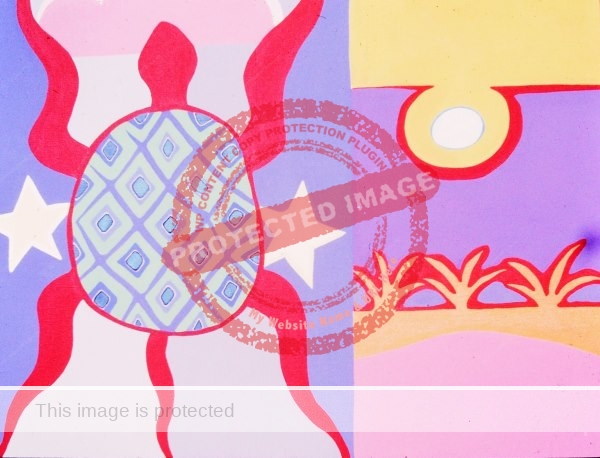
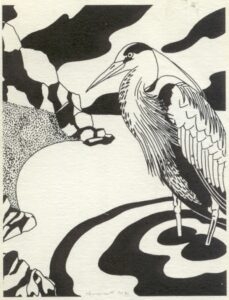

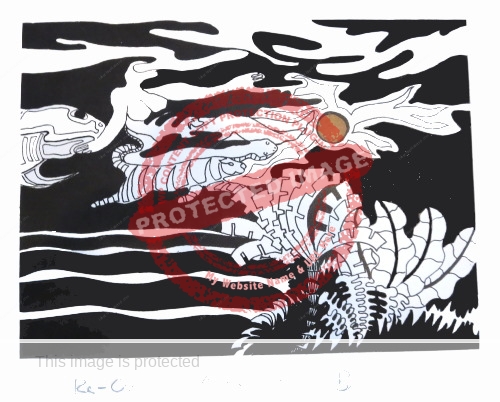
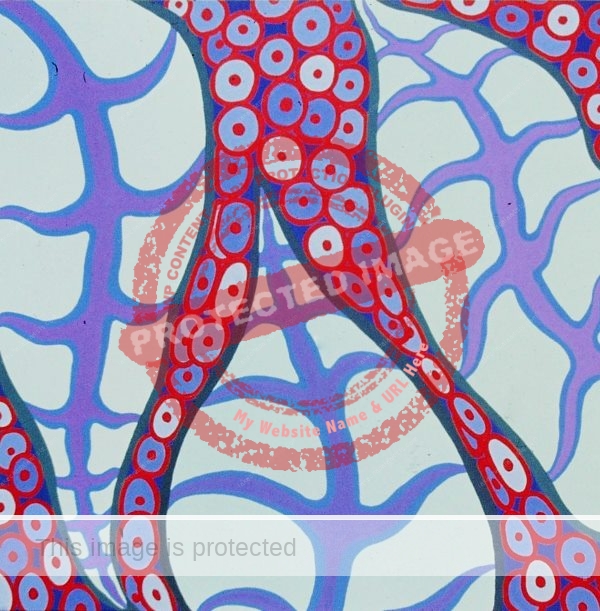
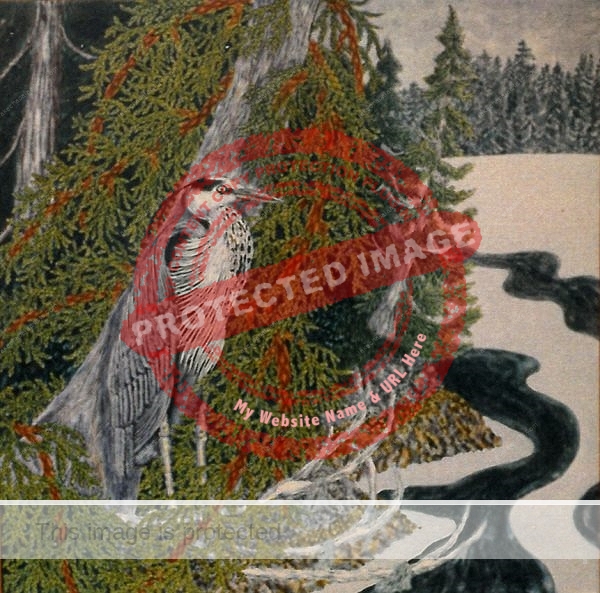
I am on the Arts Commission for the Town of Friday Harbor in Washington State. There is a mural on the side wall of Friday Harbor Drug Store that we’re trying to get information about. Someone here said that Tom painted it, but I have no substantiation of this. Do you have a way of contacting him to inquire whether or not he was in fact the artist, and if so, the year that he did the mural and whether or not there were other people in town who helped? I’d appreciate any help you can offer! Many thanks, Lori Stokes (loristokes3@gmail.com or 360-378-4643).
I am on the Town of Friday Harbor’s Arts Commission, and we are seeking information about a mural that was painted some years ago on a side wall of the Friday Harbor (WA) Drug Store. I have been told that Tom was the artist involved, but haven’t been able to substantiate this. If you could ask Tom to get in touch with me, I would be very appreciative. I want to confirm the name of the artist, the year it was painted, and whether or not other people were involved. Thanks, Lori Stokes
Thanks for your comment. I’ve passed on your contact details to Tom and hopefully you will hear from him shortly.
He gave me a complete list of his murals, and they include four in Friday Harbor.
1. “Centennial Mural” (10 x 10) [feet] painted June 1972.
2. “Centennial Mural for 12 years and Under” (3 x 100), painted July 1972.
3. “Washington House Realtors” (7 x 4) – 1975
4. Friday Harbor High School – 560 sq ft, 1979 [one of his “People’s murals”]
Hope this helps and that he gets in contact with more details,
I’d be interested to learn more about all four murals, especially if they still exist!
Regards, Tony
Hi Tom…
The Heron… one of a set of 4, which included the Seagull. I met you through an acquaintance in the mid ’70’s and visited in Wash. I still have the most enjoyable prints which I came home with. Several are framed and enjoyed by others; some are still only mounted.
Thanks and take care…Cameron